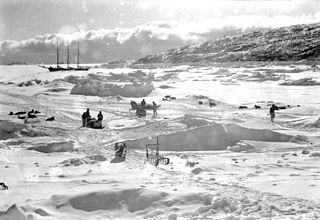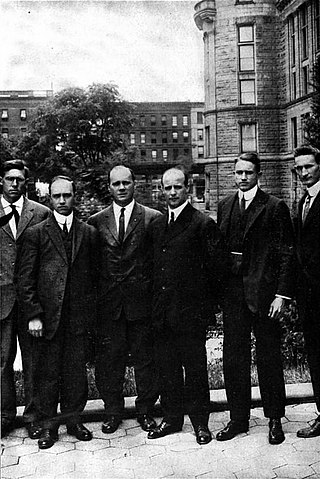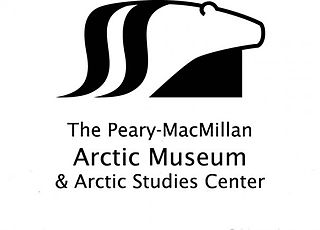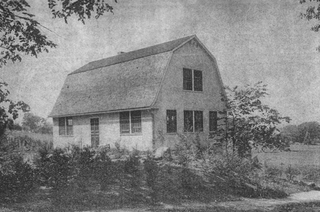
Knud Johan Victor Rasmussen was a Greenlandic-Danish polar explorer and anthropologist. He has been called the "father of Eskimology" and was the first European to cross the Northwest Passage via dog sled. He remains well known in Greenland, Denmark and among Canadian Inuit.

Robert Edwin Peary Sr. was an American explorer and officer in the United States Navy who made several expeditions to the Arctic in the late 19th and early 20th centuries. He was long credited as being the discoverer of the geographic North Pole in April 1909, having led the first expedition to have claimed this achievement, although it is now considered unlikely that he actually reached the Pole.

Sigma Pi (ΣΠ) is a collegiate fraternity with 232 chapters at American universities. As of 2021, it had more than 5,000 undergraduate members and over 118,000 alumni. The fraternity is headquartered in Nashville, Tennessee.

Donald Baxter MacMillan was an American explorer, sailor, researcher and lecturer who made over 30 expeditions to the Arctic during his 46-year career.

A Fata Morgana is a complex form of superior mirage visible in a narrow band right above the horizon. The term Fata Morgana is the Italian translation of "Morgan the Fairy". These mirages are often seen in the Italian Strait of Messina, and were described as fairy castles in the air or false land conjured by her magic.

Harry Whitney was an American sportsman, adventurer, and author. He traveled to northern Greenland with Robert Peary in 1908, staying over the winter with the Inughuit at Etah and Annoatok. In the spring of 1909 Whitney found himself at the center of the controversy between Frederick Cook and Peary over who had reached the North Pole first. A year after his return, he published a book on the trip. He is sometimes confused with his contemporary Harry Payne Whitney, who was no relation.

Bowdoin is a historic schooner built in 1921 in East Boothbay, Maine, at the Hodgdon Brothers Shipyard. Designed by William H. Hand, Jr. under the direction of explorer Donald B. MacMillan, the gaff-rigged vessel is the only American schooner built specifically for Arctic exploration. She has made 30 trips above the Arctic Circle in her life, three since she was acquired by the Maine Maritime Academy as a sail training ship in 1988. She is currently owned by the Academy, located in Castine, Maine, and is named for Bowdoin College.

The MacGregor Arctic Expedition was a privately funded expedition which set out to reoccupy Fort Conger, Ellesmere Island, Canada, a site within flying distance of the North Pole. The expedition, which took place from July 1, 1937, to October 3, 1938, had four main objectives: To collect weather data; to make a magnetic survey; to photograph the aurora borealis and study its effects upon radio transmission; and to explore the area northwest of Ellesmere Island, in order to clear up the questions about Crocker Land, which Robert Peary placed on the map more than 30 years earlier.

A.W. Greely was a three-masted wooden schooner that became known for her role in the MacGregor Arctic Expedition, a privately funded expedition to the North Pole between July 1, 1937, and October 3, 1938.

The Crocker Land Expedition took place in 1913. Its purpose was to investigate the existence of Crocker Land, a huge island supposedly sighted by the explorer Robert Peary from the top of Cape Colgate in 1906. It is now believed that Peary fraudulently invented the island.
Cape Thomas Hubbard is a headland located in the northern Canadian territory of Nunavut. Projecting into the Arctic Ocean, it is situated on the northern tip of Axel Heiberg Island, 320 mi (510 km) from Etah, Greenland.

Walter Elmer Ekblaw was an American college professor who served as geologist, ornithologist and botanist on the Crocker Land Expedition (1913-1917).

The Peary–MacMillan Arctic Museum is a museum located in the John and Lile Gibbons Center for Arctic Studies at Bowdoin College in Brunswick, Maine. Named after Arctic explorers and Bowdoin College graduates Robert E. Peary and Donald B. MacMillan, it is the only museum in the lower 48 states of the United States dedicated completely to Arctic Studies.

Tanquary Fiord is a fjord on the north coast of the Arctic Archipelago's Ellesmere Island, Nunavut, Canada. It is located in the Quttinirpaaq National Park and extends 48 km (30 mi) in a north-westerly direction from Greely Fiord.

The Apiary Laboratory, more often referred to as the Apiary, is a research laboratory at the University of Massachusetts Amherst. Originally built for the study of honey bees and apiculture, today it is primarily used to study native pollinator species and the chemicals and pathogens impacting their populations. This academic building is unique in that it is credited as being the first in the United States to be erected exclusively for the teaching of beekeeping.

The USCGC North Star was a United States Coast Guard Cutter during the Second World War. It was originally built for the U.S. Interior Department and served in the United States Coast Guard (USCG) before being acquired by the U.S. Navy.

Josephine Elizabeth Tilden was an American expert on pacific algae. She was the first woman scientist employed by the University of Minnesota. Tilden established a research station in British Columbia which lasted only until 1906. When Tilden became an assistant Professor in 1903, she was the first female scientist employed by the University of Minnesota. In 1910, despite not having a doctorate, Tilden was promoted to full professor.
Alfred Otto Gross was an instructor, ornithologist, and professor of biology at Bowdoin College. He went on two Arctic expeditions to study birds in the region. He studied numerous North American bird species including the ruffed grouse, snowy owl, and goshawk but is best known for his studies of the last populations of the now-extinct heath hen.
Miriam Norton Look MacMillan was an American sailor, author, lecturer, photographer, and explorer.
















